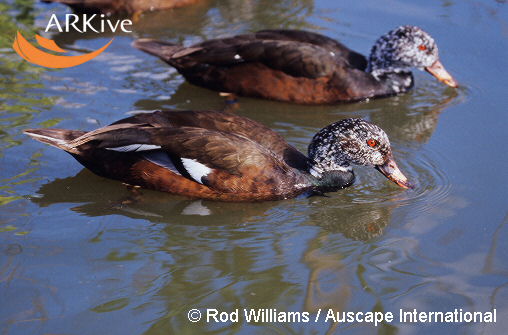
Cairina scutulata
Cairina scutulata NatureServe Explorer Species Reports — NatureServe Explorer is a source for authoritative conservation information on more than 50,000 plants, animals and ecological communtities of the U.S and Canada. NatureServe Explorer provides in-depth information on rare and endangered species, but includes common plants and animals too. NatureServe Explorer is a product of NatureServe in collaboration with the Natural Heritage Network.
ITIS Reports — Cairina scutulata ITIS (the Integrated Taxonomic Information System) is a source for authoritative taxonomic information on plants, animals, fungi, and microbes of North America and the world.
FWS Digital Media Library — The U.S. Fish and Wildlife Service’s National Digital Library is a searchable collection of selected images, historical artifacts, audio clips, publications, and video.This is one of the largest living species of duck next only to the steamer ducks which are heavier. The Muscovy duck also attains sizes that nearly rival the white-winged duck, but may average a bit smaller in a wild state. Length is 66–81 cm (26–32 in) and wingspan is 116–153 cm (46–60 in).Males weigh 2.94–3.9 kg (6.5–8.6 lb), while females weigh 1.95–3.05 kg (4.3–6.7 lb). The most noticeable feature on adult birds, is the dark body contrasting with a whitish head and neck. Males have mostly dull yellowish bill, blackish mottling on the head and upper neck, white lesser median coverts and inner edges of tertials and bluish-grey secondaries. In flight, white wing-coverts contrast with the rest of the wings. Females are smaller and usually have more densely mottled head and upper neck. The juvenile is duller and browner
| Status | Date Listed | Lead Region | Where Listed |
|---|---|---|---|
| Endangered | 06/02/1970 | Foreign (Headquarters) | Wherever found |
- Countries in which the the White-Winged Wood duck, Wherever found is known to occur: India, Indonesia, Malaysia, Thailand
| 06/02/1970 | 35 FR 8491 8498 | Part 17 - Conservation of Endangered Species and Other Fish or Wildlife (First List of Endangered Foreign Fish and Wildlife as Appendix A) |
| 04/14/1970 | 35 FR 6069 | Notice of Proposed Rulemaking (Endangered Species Conservation); 35 FR 6069 |












